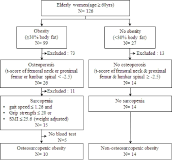
Purpose The purpose of this study were to assess physiological and biochemical characteristics in elderly women with osteosarcopenic obesity (OSO), and to analyze relationships among irisin, adipokines and bone metabolism markers. Methods 126 elderly women were selected and among them 10 women were classified into OSO group (76.9±5.2 yrs) and 14 women were classified as a NOSO group (72.9±5.6 yrs). Physique, body composition and bone mineral density were measured. Senior fitness tests were 30-s chair stand, 30-s arm curl, chair sit-and-reach, back scratch, 8-foot up-and-go, grip strength, and 2-min step test. Isokinetic muscle strength was measured by isokinetic dynamometer (Cybex 770, USA). Nutrition intake and physical activity were administered. Biochemical parameters including irisin, FNDC-5, leptin, adiponectin, CTx, 25(OH)D, osteocalcin, and PTH were measured. All data were analyzed by SAS 9.4. Independent t-test was applied to compare between OSO and NOSO groups. Multiple regression analysis was used. The level of significance was set at .05. Results The results of the study showed that there were significantly high for waist circumference, hip circumference, WHR, and BMI in OSO group compared to those of NOSO group. Higher results were also obtained for fat tissue and percent body fat but significantly low for lumbar bone mineral density. OSO group showed significant lower results for grip strength and 2-min step test compared to NOSO group. Peak torque, and relative peak torque at 60° were significantly lower for left and right knee flexion in OSO group. Protein intake was significantly low in OSO group, but no difference was obtained in level of physical activity between two groups. Irisin was significantly related to adiponectin, FNDC-5 and osteocalcin in explaining 35.2%, 81.5% and 92.1% of the variance, respectively. Conclusions This study shows that elderly women with OSO have higher results for physique and body composition parameters except body height. However, lower values were obtained for functional fitness, and isokinetic muscle strength. OSO may have more risks for metabolic syndrome, bone fractures, fall, lack of daily physical activity and limit of locomotion due to the imbalance of quadriceps and biceps femoris in non dominant leg. This study suggests that criteria and mechanism of OSO should be clarified by follow-up study.

Purpose This study was designed to examine the effects of 8 weeks of circuit exercise training on blood lipids, insulin resistance, cardiovascular function, and metabolic syndrome risk factors in 40~50s male bus drivers. Methods Twenty-nine bus drivers were randomly assigned to one of two groups, i.e., circuit exercise training group (TR: n=14) and control group (CON: n=15). Subjects in TR participated in circuit exercise training 30-40 min per session, three sessions per week for 8 weeks, whereas subjects in CON were asked to maintain their normal life pattern for same intervention period. The variables regarding body composition, blood lipids, insulin resistance, cardiovascular function, and number of metabolic syndrome risk factors were measured and compared between two groups as well as between pre- and post-test. Data were analyzed using repeated two-way ANOVA with post hoc test. Results Main results of the present study were as follows: 1) Waist circumference, waist-hip ratio, body mass index, and percent body fat decreased significantly in TR. 2) LDL-C decreased and HDL-C increased significantly in TR. 3) Fasting plasma insulin and HOMA-IR decreased significantly in TR. 4) Regarding cardiovascular function, diastolic blood pressure and mean arterial pressure decreased significantly in both TR and CON. hs-CRP were not changed significantly; however, it tended to be decreased TR. 5) Number of metabolic syndrome risk factors decreased significantly in TR(2.86±0.86 to 1.50±0.76). Conclusions It was concluded that 8 weeks of circuit exercise training would be beneficial for improvement of blood lipid profiles and insulin resistance, resulting in preventing metabolic syndrome. In particular, it would be very clinically meaningful that number of metabolic syndrome risk factors decreased from 2.86±0.86 to 1.50±0.76 by the circuit exercise training.
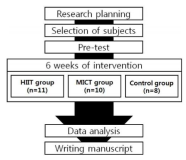
The primary purpose of this study was to investigate the effects of 6 weeks of high-intensity intermittent training (HIIT) and moderate-intensity continuous training (MICT) under relatively equal energy expenditure on body composition, aerobic capacity, cardiovascular function, insulin resistance, and blood lipid profiles in 20s overweight males. Twenty-nine males were randomized into one of the following groups: HIIT group (n=11), MICT group (n=10), and control group(n=8). Subjects in HIIT group completed 6 weeks of training for 25 min/sessions, three times/wk, and subjects in MICT group exercised for 33 min/session to equalize the energy expenditure with HIIT group. Subjects in control group were asked to maintain their normal life pattern during the same intervention period. Data were analyzed using two-way repeated measures ANOVA with post hoc test. Main results of the present study were as follows: 1) Body weight, BMI, fat mass, and WHR decreased significantly in HIIT group. 2) VO2max, VEmax, and time to exhaustion increased significantly in HIT group. 3) SBP decreased significantly in HIIT group and HRrest was tended to decrease in HIIT. 4) Fasting plasma insulin and HOMA-IR were tended to decrease in HIIT, but the changes failed to reach the statistically significant level. 5) HDL-C and TG were tended to improve in HIIT, but the changes failed to reach the statistically significant level. Results indicate that high intensity intermittent exercise training is more beneficial in aerobic capacity and cardiovascular function. It was also suggested that 6 weeks of aerobic exercise training in either high intensity intermittent or moderate intensity continuous was not sufficient enough to induce changes in body composition, insulin resistance and blood lipid profiles.

PURPOSE The purpose of this study was to investigate the characteristics of field and on-ice performances of ice-hockey players and the relationship of performance with subjective joint pain and dysfunction. METHODS A total of 25 male college icehockey players were evaluated for 19 items of performance. Pain and dysfunctions in the lower extremities and lower back were confirmed through the Foot and Ankle Outcome Score, Knee Injury and Osteoarthritis Outcome Score, Hip Dysfunction and Osteoarthritis Outcome Score, and Osweatry Disability Index questionnaire. Players with similar performance characteristics were classified through a cluster analysis, and differences in performance and patient-reported outcomes between clusters were analyzed with a one-way analysis of variance. RESULTS The ice-hockey players were classified into “lower muscular strength and performance (cluster 1),” “lower cardiorespiratory endurance (cluster 2),” and “high muscular strength and performance (cluster 3).” Players in cluster 1 had more frequent ankle and knee joint dysfunctions and pain compared to those in cluster 3. Several performance test items affected the subjective joint score, and the related performance items were more in the proximal joint than in the distal joint. CONCLUSIONS Ice hockey players should perform training to supplement their individual lack of on-ice and field performance. Since performance may be limited because of joint dysfunction and pain, a joint-specific intervention strategy should be applied to improve physical and athletic performances.

The purpose of this study was to classify high school baseball players as superior or inferior group by Functional Movement Screen(FMS) and to provide basic information for finding great pitcher and improving exercise performance by comparing and analyzing the pitching motion. The results of this study are as follows. The inferior group’s center of mass(COM) moved significant on the left side than superior group at heel contact(HC), ball release(BR), and follow throw(FT)(p<.05). There were no significant difference in linear velocity of shoulder, elbow and wrist between two groups, but inferior groups showed large difference in each joint. The superior group controled rotation of pelvis at HC and showed significant higher knee extension at BR and FT than inferior group(p<.05). The angular velocity of superior group’s throwing arm were higher in acceleration period(p<.05). Taken together based on the results, the players who have higher muscle function showed great pitching motion, so we can conclude that FMS could be useful for evaluating the potential of pitcher.

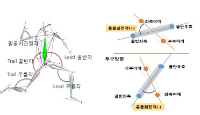

Purpose The aim of this study was to investigate the effects of treadmill exercise on mitochondrial quality control in the APP/sw transgenic mice model of Alzheimer's disease(AD). Methods The experimental mice were divided into non-tg-control (NTC, n=10), tg-control (TC, n=10), and tg-exercise (TE, n=10), and treadmill exercise was conducted for 12 weeks (15m/min, 60min, 5 times/week). And then, we measured the cognitive function using MWM and the brain cortex was evaluated to determine whether any changes in the oligomer Aβ, apoptotic-related factors, mitophagy and mitochondrial biogenesis. Results As a result, treadmill exercise significantly reduced oligomer amyloid and also had a positive effect on proteins (PUMA, Bax, Bcl-2) associated with apoptosis. In addition, through the treadmill exercise, PINK-1 decreased, and increased parkin, showing that active inhibition of mitophagy has been partially relaxed. It has been confirmed that the key autophagy markers LC3 and p62 significantly reduce p62 expression in TE group compared to TC group, and that LC3-II/LC3-I ratio tended to decrease, although not significant, increasing the activity of mitophagy. Next, proteins related to mitochondrial biosynthesis (SIRT-1, PGC-1α, Tfam, and COX-IV) have been identified, and the treadmill exercise has confirmed that the expression of all proteins has increased in part. Finally, cognitive has been shown to improve cognitive by shortening both swimming distance and time through treadmill exercise. Conclusions Thus, our finding suggested treadmill exercise alleviates cognitive dysfunction by improving mitochondrial quality control(mitophagy, mitochondrial biogenesis) and neuronal cell death via reducing amyloid accumulation, which may play a role in a preventive strategy for AD.



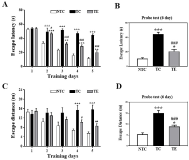
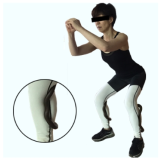
Purpose This study was designed to investigate the effects of weight-bearing exercise and CareRing treatment on cardiovascular responses, popliteal vein functions, and vascular elasticity of 30-40s women who had worked longer than eight hours a day in a standing position. Methods Thirteen subjects participated in 30 min of standing up treatment (STAND), weight-bearing exercise treatment (EX), and weight-bearing exercise with CareRing treatment (EX+RING). Each subject took part in the three trials repeatedly in a counter-balanced order and proceeded with a wash-out period of at least one week between the respective trials. Results The main results were as follows: 1) Significant reduction in EDV, no change in the diameter of popliteal vein, trend of reduction in blood flow of popliteal vein, and increased baPWV, indicating reduction of vascular elasticity of whole body, were shown in the STAND. 2) CO and EF increased significantly, and TPR decreased significantly in the EX. Blood flow velocity and blood flow volume of popliteal vein increased significantly, and baPWV decreased significantly from immediately after the treatment throughout the recovery phase in the EX. 3) HR, CO, and EF increased significantly in the EX+RING. Blood flow velocity and blood flow volume increased significantly in the EX+RING. Diameter of popliteal vein increased significantly immediately after the treatment and decreased significantly at 40 minutes of recovery. TPR and baPWV decreased significantly immediately after treatment compared to the STAND. Conclusions It was concluded that weight-bearing exercises would be effective in preventing venous or cardiovascular diseases occurred due to long-standing in 30-40s women, who are at high risk for such diseases. Furthermore, it would be more effective to combine pressure treatment with CareRing during weight-bearing exercises.


The purpose of this study was to examine the effects of congruence type between sporting event and corporate sponsor as well as the effects of advertisement exposure frequencies (1, 3 or 5 times) on advertisement attitude and advertisement effectiveness, including brand attitude and advertisement wear-in and wear-out effects. Data (N=150) were collected using a convenience sampling method and 3-group random assignment. The collected data were analyzed by means of frequency analysis, reliability analysis based on factor rho coefficient, correlation analysis, one-way ANOVA, confirmatory factor analysis, and latent mean analysis. The results were as follows; firstly, in case of higher functional congruence condition, advertisement attitude was most positive in a 3-time exposure situation and it decreased as advertisement exposure frequency further increased. However, in the lower functional congruence situation, advertisement attitude was continuously decreased as advertisement exposure frequencies increased. Secondly, in the higher image similarity situation, advertisement attitude was increased as advertisement exposure frequencies increased. On the other hand, in the lower image congruence situation, advertisement attitude was decreased as advertisement exposure frequencies increased. Lastly, advertisement attitude, brand attitude, and wear-in effects were statistically higher in the high functional and image congruence situations than did in the low functional and image congruence situations.



Purpose The purpose of this study is to grasp consumers' perception of badminton racket brand image using MDS and ISA. Methods To do this, we conducted questionnaires on those who participated in badminton and had experience of participating for 6 months or more in Seoul and Gyeonggi province from April 12 to 28, 2017, selected and analyzed a total of 313 copies as valid samples of this study. Results The results of study are as follows. First, as a result of MDS analysis, it showed that only the price of brand image attributes were in order of Trion > Joobong > Lining > Victor > Yonex, and the other attributes(Design, Functionality, Quality, Awareness, Advertising image, Event, Color, Popularity, Sophistication, Originality, Trust, Service) were in order of Yonex > Victor > Lining > Joobong > Trion. Second, as a result of ISA analysis, in I quadrant, Yonex showed functionality, quality, sophistication, and trust and Trion showed price, design, functionality and quality, Victor showed price, design, functionality, quality, color, sophistication, trust, service, and Joobong showed price, functionality, quality, and trust in this area. In quadrant Ⅱ as concentrated area, Yonex showed price and service, Trion showed color, trust, service, Victor showed price, Lining showed trust and service, and Joobong showed service in this area. In quadrant Ⅲ as low rank, Yonex showed advertising image, event, Trion showed awareness, advertising image, event, popularity, sophistication, originality, Victor showed advertising image, event, popularity, originality, Lining showed awareness, advertising image, event, popularity, originality, and Joobong showed design, advertising image, color, popularity, sophistication in this area. In quadrant IV as excess avoidance, Yonex showed design, awareness, color, popularity, originality, Victor showed awareness, Joobong showed awareness, event, originality in this area.



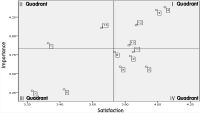




PURPOSE This study investigated the associations between mental health and physical activity with all-cause mortality in persons with disability. METHODS A total of 595 participants (39.3% women) aged 45≥ years, who participated in the Korean longitudinal study of aging (KLoSA) were included in this study. The Korean version of mini-mental state examination (K-MMSE) and the center for epidemiologic studies depression scale (CES-D) were used to assess cognitive impairment and depressive symptoms, respectively. The participants were classified into active and inactive groups based on physical activity of 150 min/week. Cox’s proportional regression analyses were used to determine the hazard ratio (HR) and 95% confidence interval (CI) of mental health and physical activity relating to all-cause mortality. RESULTS During the follow-up period (11.8±4.1 years), a total of 218 (36.6%) deaths occurred from all-causes. Participants in the inactive group had significantly higher cognitive impairment (p =0.046), depressive symptoms (p =0.001), and all-cause mortality (p=0.037) than those in the active group. Compared to participants in the normal (HR=1), cognitive impairment (HR=2.229, 95% CI=1.645-3.020, p<0.001), and depressive symptoms groups (HR=1.542, 95% CI=1.136-2.091, p<0.001), those in the inactive group had significantly higher HR related to all-cause mortality. However, in the active group, cognitive function and depressive symptoms were not associated with all-cause mortality. CONCLUSIONS The current finding suggests that the promotion of physical activity may play an important role in preventing premature death from all-causes in persons with disability, especially among those with mental health problems.